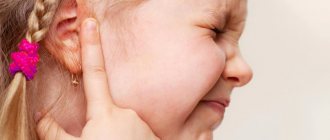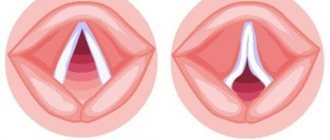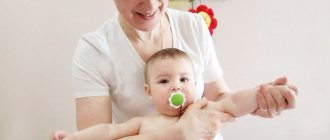Flat feet in children is a change in the configuration of the foot skeleton associated with the flattening of its arches and leading to disruption of gait mechanics.
Flat feet in children are manifested by fatigue, pain in the legs during movement and static load, swelling and deformation of the foot, changes in gait, and difficulty walking. The diagnosis of flat feet in children is established on the basis of a clinical examination, plantography data, podometry and radiography of the feet.
To treat flat feet in children, conservative methods are used (massage, therapeutic exercises, physiotherapy, plaster casts and orthoses); Surgery is performed in extreme cases.
Causes of flat feet in children
Factors that prevent normal foot formation:
- genetic abnormalities associated with abnormal development of connective tissue against the background of other disorders of the musculoskeletal system;
- injuries of the ankle, tarsus (the set of bones of the foot);
- rupture of ligaments, tendons on the arch;
- paralysis of the muscles of the foot and leg;
- rickets, which distorts the structure of bone and ligamentous tissue due to vitamin D3 deficiency.
More than 80% of cases of deformation of a child’s foot and loss of its shock-absorbing ability are associated with obesity, incorrectly selected shoes, and age-inappropriate physical activity.
Osteopathy in the diagnosis and treatment of flat feet in children
Flat feet in children most often develop due to a general imbalance in the body. The feet are just a link in the chain of emerging pathologies. They take a forced position, adapting to the body. The task of an osteopath is to identify and correct the root cause of flat feet in a child, while simultaneously eliminating all associated problems. The root cause can be “hidden” in any part of the body, but most often it is located in the skull or in the cervical spine.
To prevent flat feet in children, doctors strongly recommend periodic examinations by a specialist. The effectiveness of flatfoot treatment largely depends on how promptly the parents sought help. Until the age of 7-8, with the help of osteopathy, it is easier to return the feet to the correct position. After 8 years, you can also cure the disease by undergoing treatment for flat feet with an osteopath.
Treatment of flat feet in children should be comprehensive
To consolidate the effect of osteopathic treatment for flat feet, it is necessary to strengthen the muscles and ligaments of the foot with the help of exercises. Our specialists will conduct special gymnastics for training the muscles of the foot and lower leg with the child.
In the meantime, while the arch has not formed, orthopedic insoles will provide significant assistance in the treatment of flat feet, which you can also make directly on the child’s foot in our clinic.
Did you like the article? Add the site to your browser bookmarks
General information
Flat feet in children is the most common orthopedic pathology in pediatrics, manifested by a decrease in the height of the arches of the feet. Flat feet can be detected in a child from birth (in 3% of cases); by 2 - 4 years it is observed in 24-32% of children, by 7 years - in 40%, by 12 years - in 50% of adolescents.
The active formation of elements of the arch of the foot in children occurs gradually, with the appearance and increase of load on the legs. The critical moment in the development of flat feet is the age period from 8 months to 1.5 years, when the child begins to stand up and learn to walk. At an early age, all children have a physiological flat foot, due to age-related anatomical and functional characteristics: the cartilaginous structure of the bones, more elastic and tensile ligaments, weak muscles. With proper development with increased muscle strength and endurance, this condition in children normalizes on its own by the age of 5-6 years. With certain disorders, children develop flat feet, leading to a sharp decrease in the shock-absorbing potential of the foot, an increase in the load on other elements of the musculoskeletal system with damage to the knee and hip joints, deformation of the spine, and disruption of the functioning of internal organs.
Symptoms and signs of flat feet in children
It is important, as they age, to identify at home the main signs of flat feet in children, and in this the role of parents is great, constantly monitoring the child. They should note the rapid fatigue of children with complaints of pain and fatigue in the legs in the evening, the formation of swelling in the legs and marks from the elastic bands of socks and shoe straps. Children may complain of aching sensations and pain that develops from prolonged standing or walking; shoes quickly wear out on the inside and get worn down inside. When walking, the child's feet may be placed incorrectly, with the toes pointing inward with the heels apart, the foot widens, nails may grow in, and the toes may become crooked. calluses and corns are also common in children , which is associated with changes in the shape of the feet and support on incorrect points.
Classification of flat feet in children
The foot has longitudinal and transverse arches, supporting muscles and ligaments that provide balance to the body, distribute and soften the shock load during walking, running and jumping, and also increase endurance to axial load. Based on anatomical characteristics, orthopedics distinguishes between longitudinal, transverse and combined flatfoot. In children, longitudinal flatfoot is more common with flattening of the longitudinal arch and elongation of the foot, which is in contact with the floor with the entire surface of the sole. With transverse flatfoot in children, the length of the foot decreases, its anterior section rests on the heads of all metatarsal bones.
Flat feet in children can be congenital or acquired. The congenital form is quite rare and is associated with malformations of the bone structures and musculo-ligamentous apparatus of the foot. Acquired flatfoot in children, depending on its origin, can be static, traumatic, rachitic, or paralytic. The most common static flatfoot is more common in school-age children when there is a discrepancy between the static and dynamic load on the foot and muscle tone.
Longitudinal flatfoot by degrees.
| Degree of longitudinal flatfoot | Arch angle | Arch height |
| 1 | 130-140 ° | 35-25mm |
| 2 | 141-155 ° | 24-17mm |
| 3 | 155> ° | 17>mm |
To be fair, it should be noted that this radiological classification is used only in Russia, which is mainly caused by the excitement around issues related to the military registration and enlistment office. In the rest of the world, these angles are taken into account, especially when planning surgical treatment, but do not form a separate classification, since the angles on radiographs and the severity of the clinical picture have little correlation.
Based on the time of occurrence, congenital (associated with developmental anomalies) and acquired forms of flatfoot are distinguished. Congenital causes include such rare and severe forms as congenital vertical talus and calcaneal valgus foot. More common (from 1 to 6% of the population) and less severe causes of congenital flatfoot include calcaneonavicular, calcaneal-talus and some other synostoses, accessory navicular bone. Abnormalities of these bones lead to improper load distribution in the gait cycle and overload of the remaining stabilizers of the foot. The picture of flat feet in this case appears by the age of 8-15, which is associated with ossification and the transition of relatively elastic synchondroses into synostoses.
Depending on which of the arches of the foot is more involved in the pathological process, longitudinal and transverse flat feet are distinguished. Longitudinal flatfoot is more associated with dysfunction of the calcaneonavicular, navicular-cuneiform ligaments, plantar ligaments and plantar fascia. Transverse flatfoot is associated with dysfunction of the adductor pollicis muscle and intermetatarsal ligaments. In most cases, longitudinal and transverse flatfoot are observed simultaneously.
According to the clinical picture, there are 2 main forms of flat feet - rigid and elastic. The elastic form appears only in a standing position, and disappears when rising on the toes or in a resting position. The rigid form remains at rest.
Currently considered a variant of the norm. It is characterized by a decrease in the height of the median longitudinal arch at rest; during loading, a valgus position of the heel bone and abduction in the midfoot are noted.
Extremely widespread (occurs in 20-25% of the population). It has a genetic nature and is observed in families. Often accompanied by hypermobility syndrome in other joints. In most cases, the severity of the deformity decreases with age.
Severity of flat feet
Planovalgus deformity without proper treatment progresses inexorably:
- I degree – mild. Normally shaped feet swell and hurt after walking, but recover after rest. The height of the arch is 25-35 mm.
- II degree – intermittent. The feet are noticeably widened, the longitudinal and/or transverse arches are lowered to 25-17 mm, and the decrease in their height is more noticeable in the evening; gait is disturbed, clubfoot occurs; Due to deformation of large joints, the pain becomes longer lasting and spreads to the knee.
- III degree – the height of the arch is below 17 mm, there is a flat-valgus curvature of the foot with support on the inner part, a disease of the entire musculoskeletal system; pain intensity is higher, exercise tolerance is minimal.
Features of the development of the disease in children 3-5, 10-12 years old
Until the age of 3, the child’s foot does not yet have insteps in the support zone. Weak muscles, ligaments, and bones cannot form strong arches. Flat feet in children, how to treat it - this problem occurs at 4-5 years old, when children are already active and move a lot.
Normally, physical activity and weight gain strengthen muscles, ligaments, and stimulate the formation of the longitudinal and transverse arches. If a child’s feet have suffered from congenital or acquired negative factors, the feet cannot acquire shock-absorbing properties.
A 4-5 year old child is diagnosed with “flat feet” because he has a limp, twists his feet, is unable to run along with his peers, and constantly complains of fatigue. Flat feet in children, how to treat it, should be decided at the age of 7, since in the immediate period from 10 to 12 years, without corrective measures, the deformity worsens to degree III.
There is a roll of the feet inward, a pronounced X-shaped curvature in the heel area of the valgus type. At the same time, the thumbs are deflected inward, and the articular bones at their base are deflected outward. The metatarsal heads become overgrown with layers of cartilage tissue, which leads to protrusion of the cone. The thumbs, pushed out of their place, overlap the neighboring ones.
The lack of shock absorption in undeveloped arches increases the load on the hip joints and spine, which provokes severe pain in this area.
Degrees of flat feet in children and treatment
Flat feet are classified according to the severity of the deformity, which is determined by the foot print and x-ray.
- I degree – the deformation is not very pronounced, the height of the arches is close to normal values. In this case, the muscles and ligaments are weakened, and minor pain may be observed at the end of the day.
- II degree – the flattening of the arches is more pronounced, the child often complains of pain in the legs. There is swelling and gait changes. Treatment is definitely necessary.
- III degree – severe deformation, the child may experience severe pain in the legs and spine, and significant swelling appears. Emergency treatment for flat feet is required.
Complications of the disease
Treatment of flat feet in children, as well as a timely and correctly organized set of corrective measures, will protect against irreparable complications:
- displacement of the heel inward (varus), outward (valgus);
- neuritis, spurs, calluses;
- dystrophic and degenerative changes in the leg joints in the form of arthrosis, arthritis;
- curvature of the spine (scoliosis), intervertebral hernias, osteochondrosis;
- constant pain in the musculoskeletal system, lower back, back, head.
What is flat feet
Flat feet is a deformation of the structure of the foot, which is accompanied by a flattening of its arch. As a result, the foot comes into contact with the floor over its entire area. This makes walking difficult and causes a change in gait. The arch (bend) is a physiological shock absorber that reduces the load on the musculoskeletal system when walking, jumping, and running.
Flat feet in children can be congenital or acquired. In the first case, the deviation is due to:
- hereditary anomalies in which the child develops weak ligamentous and bone apparatus;
- genetic predisposition;
- infectious diseases and injuries of a woman during pregnancy.
Acquired flatfoot in children is associated with injuries, increased physical stress on the lower extremities, and hormonal disorders.
How to independently determine flat feet in a child
At the age of 5, signs of deformation in the baby will be noticeable even to parents without medical education. The most revealing is the footprint. To do this, the soles are lubricated with sunflower oil or watercolor paint and the child is asked to stand on clean paper for half a minute.
In the middle between the prints you need to draw a vertical axis of symmetry. From it to the narrowest painted area, a perpendicular line is laid to the outer edge of the print.
The comparison is simple:
- the horizontal segment in the unpainted area is longer than in the painted area, which means the rise is quite high;
- the shaded area is wider, which means the arch is lowering;
- The entire foot is completely imprinted, which means the degree of flattening is maximum.
Transverse deformation is difficult to detect in this way. This type of flatfoot is noticeable when the feet are already widened in the forefoot and there are problems with shoes.
Ways to independently determine flat feet in a child
At home, you can detect flattening of a child’s foot using the following method:
- take a sheet of paper and place it on a hard, flat surface;
- lubricate the child’s foot with greasy cream or cover it with paint;
- place your foot on the paper, but the child should not rest his hands on anything.
You can evaluate the results by the imprint left behind. If the middle of the foot is completely reflected on the sheet, then there is a suspicion of flattening of the arch. Normally, only fingerprints, the outer edge of the foot and the heel should remain on the sheet.
Clinical diagnostic methods
Several methods are used in pediatric diagnosis of flat feet:
- Podography, using shoes with sensitive contacts, records the straightness of movement, the angle of rotation of the foot, the width of the step, the duration of each phase;
- electromyography examines activity and muscle tone;
- computer testing while walking barefoot on a special platform monitors the biomechanics of movement.
If these methods are not enough for the doctor, radiography is prescribed.
Treatment of flat feet in children
Flat feet in children is a progressive disease that requires treatment. The sooner it is started, the more effective the results will be. If congenital flat feet are detected, the fight against it starting from the first weeks of the child’s life. This makes it possible to completely get rid of foot deformities. For congenital flat feet, the following treatment methods are used:
- Massage of the muscles of the foot and lower leg.
- Keeping the foot in the correct position. The action is performed using bandaging and applying staged plaster casts. The above methods can only be used if the child is already 6 months old.
- Special therapeutic exercises are carried out.
- If the case is advanced, surgical intervention may be performed.
- If flat feet are detected in an older child, all actions are aimed at strengthening the musculo-ligamentous apparatus of the foot. A person who has been diagnosed with a pathology will be referred to a course of exercise therapy, massage and physiotherapy. Young children suffering from the disease should not wear soft shoes. Czech shoes, felt boots and rubber boots should be excluded from the wardrobe. It is recommended to wear boots that have a hard sole with a small heel. Shoes should support the ankle joint well. If the disease is detected at an older age, it is necessary to wear special orthopedic shoes that have an insole-support. It lifts the dropped arch of the foot and returns it to its normal position. This allows you to unload the limbs, distribute the weight evenly and get rid of possible consequences.
- To get rid of the problem, the doctor may prescribe hydromassage, magnetic therapy or contrast foot baths. Mud, paraffin or ozokerite applications can also give a positive effect. If the above methods do not help get rid of the pathology, the use of a splint and plaster casts is prescribed. If a child has severe combined flatfoot, surgical intervention is possible. The operation is performed on the bone and soft tissues of the foot and leg. Usually the action is not performed at an early age. The operation can be prescribed for children who have reached 8-12 years of age.
Weak and moderate forms of flat feet in children are completely curable if correction is started in a timely manner. Returning the foot to its correct shape in advanced cases of pathology is quite problematic. Severe stages of the disease are difficult to correct. After long-term treatment, slight improvement may occur. However, if the problem is not dealt with, the child may experience severe deformation of the foot, as well as joints and spine.
Types of flat feet
From a biomechanical point of view
- Functional
With functional flatfoot, the foot does not flatten completely even in a standing position. But under load, the foot “sags” greatly, the longitudinal arch drops, and with each step it tilts inward (foot valgus). This entails the emergence of various problems with the spine, ankle and knee joints, as well as with health in general. But most of all, with this type of flatfoot, the foot itself suffers, since the support now falls mainly on two points - the heel and the joint of the big toe (the first metatarsophalangeal joint. As a result, the big toe deviates outward (abduction, valgus), and the joint gradually increases in volume.
- Anatomical flatfoot
Anatomical flatfoot does not pose as much of a health hazard as functional flatfoot and is less likely to bother the patient. With this type of flatfoot, the foot always has a flattened longitudinal arch - both under load and in a free state.
By origin
Flat feet in children are divided into two types - congenital and acquired .
Congenital flat feet in children are rare when, under the influence of various factors, the child’s musculoskeletal system is formed incorrectly. These could be genetic diseases, illnesses suffered by the mother during pregnancy, the “uncomfortable” position of the fetus in the womb, etc.
Types of acquired flat feet
In most cases, flat feet in children is acquired and is divided into types in terms of direction:
- Longitudinal.
The longitudinal arch along the inner and outer edges of the foot is affected, and the angle between the heel and metatarsal bones increases. In advanced cases, the entire surface of the foot comes into contact with the floor, its length increases, and the mobility of the ankle joint decreases.
- Transverse.
The arch under the fingers is affected. The foot becomes wider in the forefoot, the middle toe becomes deformed, and the big toe deviates outward. It occurs, as a rule, as a result of wearing low-quality high-heeled shoes, when the support is not on the entire foot, but only on its front part. This type of flatfoot usually occurs no earlier than adolescence.
- Combined.
This type of pathology combines signs of longitudinal and transverse flatfoot; both arches are affected.
- Valgus flatfoot.
It is formed, as a rule, as a result of a decrease in the longitudinal arch and is accompanied by deformation of the foot. With this type of flatfoot, there is usually a deviation of the axis of the ankle joint - when viewed from above, the feet resemble the letter X.
Acquired flatfoot is also usually divided according to the reasons that led to its development:
- Traumatic
Develops as a result of damage to the ligaments and being in a cast after fractures of the bones of the feet and ankles;
- Static
A common type of flatfoot. Develops with increased stress on the feet due to excess weight (obesity). It can also occur due to prolonged standing in a standing position, combined with wearing uncomfortable shoes. Less commonly – for various diseases leading to weakening of muscles and ligaments;
- Paralytic
Develops as a result of decreased muscle tone in the legs, for example, after suffering from polio;
- Rachitic
A consequence of rickets suffered by the child, various connective tissue pathologies and general exhaustion of the body.
Review of treatment methods for flat feet
Flat feet can be treated both conservatively and surgically, but in pediatric practice they always try to choose conservative methods that are more gentle and less traumatic. We will tell you about them in more detail.
Orthopedic shoes
Wearing orthopedic shoes is an integral part of flatfoot treatment. You can buy it in a special orthopedic salon. It is better to go there with written recommendations from an orthopedic surgeon, who will indicate all the parameters of the child’s foot - height, width, points of deviation from the norm, angle of deviation, angle of rotation when walking.
If a pair that matches the exact parameters of the child’s leg is not available, it will be made to order according to individual measurements.
Strict requirements are imposed on orthopedic shoes. The initial stages of the disease usually do not require wearing a heavy medical orthopedic pair; it is quite enough to limit yourself to orthopedic insoles, but even a moderate degree of flat feet may be an indication for special corrective shoes.
It usually has a high back that secures the ankle, a soft sole, orthopedic insoles, a wide rounded or square toe, arch supports, and a low heel. This pair gives the leg additional stability and fixation.
Many parents believe that wearing orthopedic shoes helps prevent flat feet. This is a dangerous misconception. Heavy and rather massive orthopedic shoes, created specifically to correct foot deformities, are not suitable for preventive wear.
They are forced to buy it when the orthopedic doctor insists on it. Only insoles can be used prophylactically, and even then not all of them.
Massage and manual therapy
Manual techniques for influencing a child’s feet in combination with other methods give very good results and can correct flat feet. This treatment does not have a quick effect, but the benefits of systematic procedures will pleasantly surprise both parents and the orthopedic doctor.
The essence of the effect is to knead, improve blood circulation, elasticity of the calf muscles, foot muscles, the weakness of which led to the problem. After several courses, the muscles tighten and the contour of the foot begins to take shape.
A chiropractor and a professional massage therapist will show parents how to properly influence the child’s lower limbs and spine in order to subsequently carry out massage at home.
While manual manipulation is quite difficult to reproduce at home, any mother can master massage. The session includes several stages:
- impact on the foot (stroking, kneading);
- massage of the lower leg (movements from bottom to top, and not vice versa, fairly deep kneading with an emphasis on the inside of the lower leg);
- impact on the hips and buttocks (a shallow, painless vibration technique is best suited to relieve tension from the knee and hip joints).
The massage can be completed with warm foot baths followed by intensive rubbing of the feet with a hard towel.
Physiotherapy
There are several dozen exercises that will help cure flat feet in children and adolescents, making the treatment process interesting and even enjoyable. But only a physical therapy doctor can recommend specific exercises, who will take into account the type and stage of the abnormal development of the feet.
Children with flat feet are recommended to initially attend a physical therapy group at the clinic at their place of residence. There, a specialist will teach the child and his parents the basic techniques of therapeutic gymnastics.
It is advisable to conduct classes in a playful way, especially for children of preschool and primary school age, since classes should be enjoyable.
The following exercises are considered the most useful for foot deformities:
- walking on toes;
- walking on heels;
- walking on the outside of the foot;
- rolling from toes to heels.
You can do all these exercises not only on a flat floor, but also on a special applicator mat.
For treatment, orthopedic mats with a harder texture are usually recommended, while for prevention, softer mats can be used.
A certain relief pattern and the degree of rigidity of the product will be indicated by the orthopedist who is observing the child.
It is better to perform the exercises barefoot. If you experience pain in your legs while exercising on the mat, you should stop, rest and try again. Forcing a child to overcome pain is not the best tactic.
Physiotherapy
Physiotherapeutic procedures, such as electrophoresis, magnetic therapy sessions, UHF and so on, are designed to reduce pain in the lower extremities, improve blood circulation, strengthen muscle tissue, so such procedures are an excellent addition to the main treatment - massage, gymnastics, wearing orthopedic shoes.
Correction of pathology becomes more effective. Most children's clinics have their own physical therapy rooms; parents are only required to follow a schedule for visiting procedures.
Kinesio taping
The taping method is considered relatively new for orthopedics, while rehabilitation medicine has been familiar with it for a long time. The essence of the method is the application of special adhesive tapes, which redistribute the load on certain muscles, supporting certain muscle groups from the outside, and thereby straining others.
The therapeutic effect is present almost constantly - both during exercise, and during normal walking, and during rest.
Tapes are considered most effective specifically for children’s flat feet, when the foot is still growing. In adults, taping does not show such impressive results, although it is also quite often prescribed by orthopedists as maintenance therapy.
You can wear the glued tapes for several days, then change them. Applying tapes yourself, at least at first, is undesirable, since incorrect placement of the tape can lead to even more significant deformations.
The tape method is not considered as an independent treatment, but it can be used as part of complex therapy.
Surgical treatment
Surgical treatment helps to get rid of stage 3 and 4 flat feet, when conservative methods cannot correct the anatomy of the foot.
In case of longitudinal flatfoot, surgical correction of the longitudinal arch is performed with tendon plastic surgery on the inside of the foot.
Children from 10 years of age can undergo subtalar arthoeresis - a minimally invasive operation with a small incision and a quick recovery period - within 24 hours the child is at home.
A titanium implant is implanted into the subtalar sinus of his foot through a small incision. The longitudinal arches are thus changed. The implant is removed by the age of 17-18, while the correct position of the arches is maintained.
Longitudinal flatfoot of the valgus type can be effectively eliminated using the so-called Evans operation. Surgeons lengthen the heel bone by implanting part of your own bone into it. The risk of rejection is minimal.
For transverse flatfoot, two types of surgical intervention are used - on the tendons and soft tissues and on the bone tissue of the feet.
The second method is to remove, in particular, the protruding “painful bone”, and sometimes several metatarsal bones. After the operation, the child will wear special sandals, which will facilitate faster, proper fusion.
After surgery, active physical activity is not recommended for a month; you should not play sports for 3 months.
You should definitely visit a physiotherapy room, where, in particular, they do electrophoresis using the SMT method - electrophoresis using painkillers, minerals, and anti-inflammatory drugs prescribed by a doctor.
How to correct foot position in children
If there is a hereditary predisposition, it is important to take measures to strengthen the muscular and ligamentous apparatus of the foot in order to prevent flat feet from progressing. Treatment tactics are determined based on the age and stage of the disease, and the form of flatfoot. It is important to understand that the techniques are used only in combination, a combination of several simultaneous influences . It is recommended to wear special corrective shoes and exercise therapy, walking barefoot on uneven surfaces, especially in summer, children should walk barefoot on sand, grass or pebbles as much as possible. Additional home exercise sets are selected by your doctor.
Walking with your bare feet on a pebble beach at sea is useful, but you can do the same at home by collecting stones on the shore and using them for exercise, or purchasing a special rug that imitates a pebble beach. A foot massage performed at home complements and consolidates the result. Due to it, the muscles in the feet are strengthened, their tension and pain are relieved, and shock-absorbing functions are gradually restored. By conducting professional massage courses in a clinic, the blood supply to the foot and its functionality are improved. All procedures are carried out only while lying down.
Important
For such a pathology, dosed exercise is useful, but only dosed loads on the foot. Dancing, skating, and weightlifting, where high loads are placed on the foot, are not recommended.
If you have flat feet, the orthopedic doctor selects individually special shoes that need to be worn constantly; they have insoles that form the correct arch of the foot and relieve the load on the legs, relieving fatigue. Shoes are made to individual measurements and to order, taking into account the age and characteristics of the foot, have hard backs and arch support, flexible soles and heels. It must be strictly in size.
Alena Paretskaya, pediatrician, medical columnist
14, total, today
( 40 votes, average: 4.90 out of 5)
Bruise on the face: how to get rid of it quickly?
Arthritis and arthrosis: what is the difference?
Related Posts
Prevention of flat feet in children
You need to take care of the correct gait before the baby starts walking. To do this, he must be examined by an orthopedist or surgeon six months and a year after birth. The experienced eye of a specialist can see even subtle prerequisites for the disease.
At an early age, it is important to prevent rickets. For this purpose, the child needs to receive a sufficient amount of vitamin D. Sunlight penetrating the skin during walks ensures the natural synthesis of the vitamin. In the cold, cloudy season, the deficit is compensated by the pharmacy equivalent. Its dosage is prescribed by the pediatrician.
It is impossible to encourage the baby to sit, stand, or walk independently ahead of time. The body knows better when soft and hard tissues are ready for such a load. The most indicative period for planovalgus changes is 3-7 years. At this age, at least once every 1-2 months, you need to carry out fingerprint testing at home, a visual comparison of the symmetry of the legs in a standing position.
Flat feet in a child
Contrary to the good old jokes about evading the army, flat feet are not a trivial ailment at all, but a serious orthopedic problem that can lead to many chronic diseases. Changes in the shape of the foot begin in childhood, so the sooner parents suspect something is wrong and show the child to the doctor, the better. Let's figure out where flat feet in children come from and how to deal with it.
0–3 years
At about a year old, an important event occurs in the baby’s life - the transition to a vertical position: the child takes his first steps, learning about the surrounding space. Up to 3 years of age, children’s feet are surrounded by a developed fat layer and visually have a flat surface, and the musculoskeletal system is not yet sufficiently developed. When a child begins to take his first steps, the fatty “pads” on the soles take on the function of springs. Gradually, the experience of independent active movements in space accumulates, and the foot takes on a normal appearance.
During this period, three pressure points form on the baby's foot, located on the heel, the area near the little toe and in the area under the big toe. These sections are fastened together by ligaments, muscles and tendons, so the entire structure forms three arches - two longitudinal (external and internal) and transverse. When walking, they act as shock absorbers, thanks to them the gait becomes light, and the legs get used to long hours of stress.
Now imagine that the arches of the foot - a kind of arches that pass between every two pressure points - sometimes, due to improper development of the musculoskeletal system (as well as some diseases), turn into straight lines and become flattened. It is no coincidence that when translated from English, flat feet are literally translated as “fallen arch.”
However, young children are not diagnosed with flat feet. However, if the child began to walk very early (before 9 months), suffered from rickets or has a hereditary predisposition to flat feet, the orthopedist can prescribe a prevention program that includes massage of the lower extremities, walking on an orthopedic rug and wearing orthopedic preventive shoes.
The purpose of such shoes is to develop the correct walking skill: the brain “remembers” the sequence of contraction and relaxation of muscles to perform a step, thanks to which the child continues to walk correctly even barefoot.
3–7 years
At this age, children develop the “adult” shape of the arches of the feet, and it is at this time that the orthopedist most often detects signs of pathology. Additional causes of flat feet in children of kindergarten age are excess weight, neurological and endocrine diseases. The disease can be suspected if the child places his legs oddly when walking, and after a long walk begins to limp.
The treatment and preventive program prescribed by the orthopedist involves the child performing special gymnastic exercises every day, swimming with fins, and sometimes physical therapy to improve muscle tone. In recent years, the method of functional taping has become especially popular - gluing special adhesive tapes onto the patient’s body to tighten the skin and ease the load on joints and muscles. The prognosis for treatment among children of this age is favorable.
Answers to frequently asked questions
Is it possible to play sports (taekwondo, karate, football, skiing). What kind?
To prevent flat feet, you can and should play sports (football, swimming, yoga, karate, skiing, etc.). For any degree of illness, the question of acceptable physical activity is resolved with an orthopedist. Some sports that involve increased stress on the foot and ankle joint (dance, ice skating, etc.) can be dangerous for a child’s immature legs.
How does flat feet affect excess weight?
Excess weight negatively affects the development of the feet, increasing their deformation.
Can a child limp due to flat feet?
Yes maybe.
If a child has flat feet, will he be drafted into the army?
Whether a conscript is fit or not depends on the degree of illness and the complications caused by it. A young man whose medical report contains one of three diagnoses will be of limited fitness:
- 3rd degree flatfoot, complicated by 2nd stage deforming arthrosis;
- flatfoot of the 3rd degree, longitudinal type;
- transverse flatfoot of the 3rd and 4th degree.
This will mean that he will be given a military ID with enlistment in the reserves.
What is the health group for flat feet in a child?
The health group is determined by the doctor taking into account the degree of the disease, the age of the child and the presence of complications.
Can a child walk barefoot on a flat floor or carpet?
Yes, but walking on a flat surface must be alternated with walking on uneven surfaces.
What shoes do you recommend buying for children under 3 years of age and older?
How to choose the right shoes for your baby - there are several rules:
- buy a new one;
- strictly in size;
- from natural materials;
- with a low, stable heel;
- wide toe;
- hard back;
- reliable fixation with clasps;
- flexible, thinnest sole;
- with a soft insole that absorbs moisture.
Orthopedic insoles and shoes should not be worn without a doctor’s recommendation.
Is flat feet associated with scoliosis or back pain?
Yes, it happens that flat feet are complicated by curvature of the spine and back pain.











